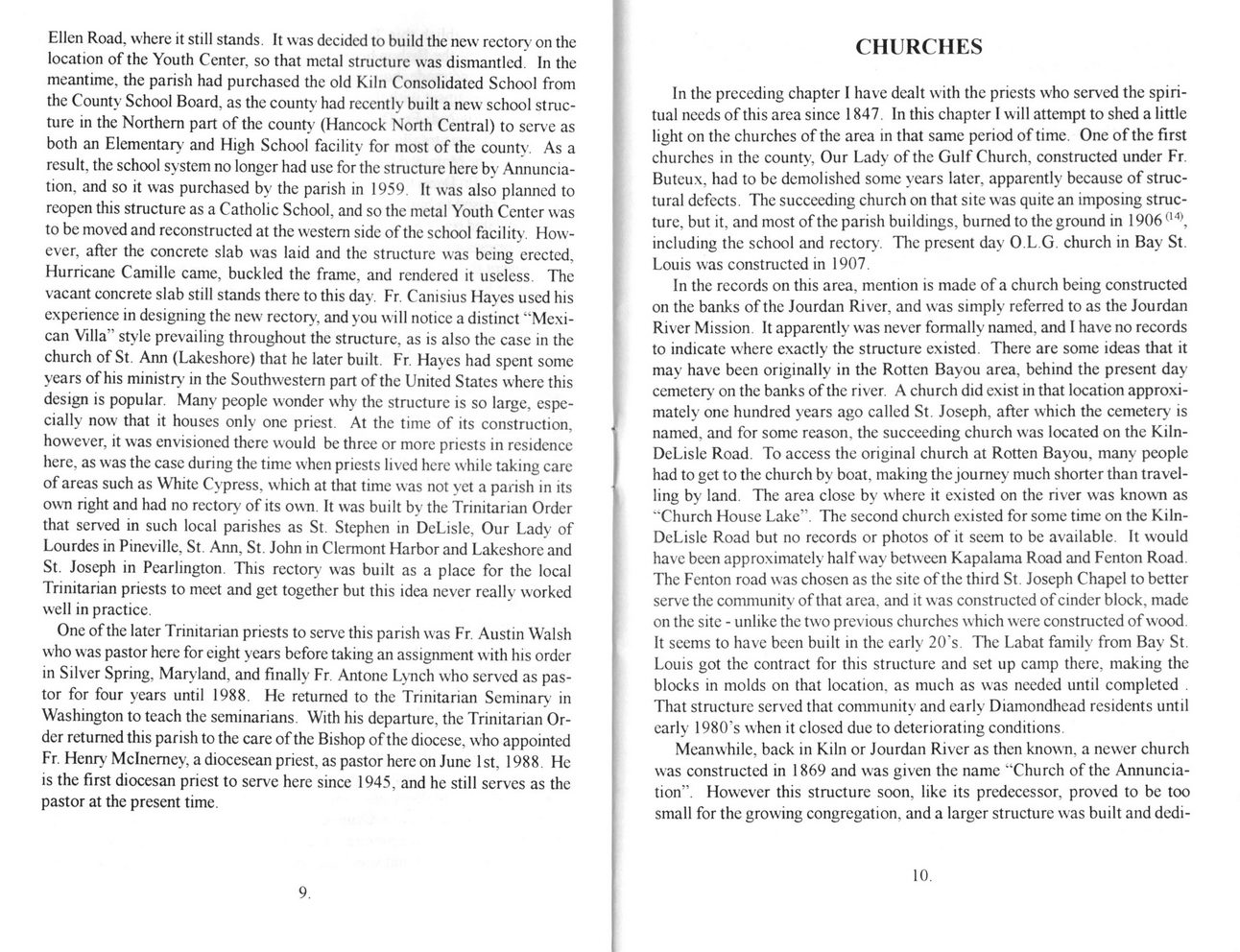This text was obtained via automated optical character recognition.
It has not been edited and may therefore contain several errors.
Ellen Road, where it still stands. It was decided to build the new rectorv on the location of the Youth Center, so that metal structure was dismantled. In the meantime, the parish had purchased the old Kiln Consolidated School from the County School Board, as the count}- had recently built a new school structure in the Northern part of the county (Hancock North Central) to serve as both an Elementary and High School facility for most of the countv. As a result, the school system no longer had use for the structure here by Annunciation, and so it was purchased by the parish in 1959. It was also planned to reopen this structure as a Catholic School, and so the metal Youth Center was to be moved and reconstructed at the western side of the school facility. However, after the concrete slab was laid and the structure was being erected, Hurricane Camille came, buckled the frame, and rendered it useless. The vacant concrete slab still stands there to this day. Fr. Canisius Hayes used his experience in designing the new rectory, and you will notice a distinct ?Mexican Villa? style prevailing throughout the structure, as is also the case in the church of St. Ann (Lakeshore) that he later built. Fr. Hayes had spent some years of his ministry in the Southwestern part of the United States where this design is popular. Many people wonder why the structure is so large, especially now that it houses only one priest. At the time of its construction, however, it was envisioned there would be three or more priests in residence here, as was the case during the time when priests lived here while taking care of areas such as White Cypress, which at that time was not yet a parish in its own right and had no rectory of its own. It was built by the Trinitarian Order that served in such local parishes as St. Stephen in DeLisle, Our Lady of Lourdes in Pineville, St. Ann, St. John in Clermont Harbor and Lakeshore and St. Joseph in Pearlington. This rectorv- was built as a place for the local Trinitarian priests to meet and get together but this idea never really worked well in practice. One of the later Trinitarian priests to serve this parish was Fr. Austin Walsh who was pastor here for eight years before taking an assignment with his order in Silver Spring, Maryland, and finally Fr. Antone Lynch who served as pastor for four years until 1988. He returned to the Trinitarian Seminary in Washington to teach the seminarians. With his departure, the Trinitarian Order returned this parish to the care of the Bishop of the diocese, who appointed Fr. Henry Mclnemey, a diocesean priest, as pastor here on June 1st, 1988. He is the first diocesan priest to serve here since 1945, and he still serves as the pastor at the present time. 9. CHURCHES In the preceding chapter I have dealt with the priests who served the spiritual needs of this area since 1847. In this chapter I will attempt to shed a little light on the churches of the area in that same period of time. One of the first churches in the county, Our Lady of the Gulf Church, constructed under Fr. Buteux, had to be demolished some years later, apparently because of structural defects. The succeeding church on that site was quite an imposing structure, but it, and most of the parish buildings, burned to the ground in 1906(14), including the school and rectory. The present day O.L.G. church in Bay St. Louis was constructed in 1907. In the records on this area, mention is made of a church being constructed on the banks of the Jourdan River, and was simply referred to as the Jourdan River Mission. It apparently was never formally named, and I have no records to indicate where exactly the structure existed. There are some ideas that it may have been originally in the Rotten Bayou area, behind the present day cemetery on the banks of the river. A church did exist in that location approximately one hundred years ago called St. Joseph, after which the cemetery is named, and for some reason, the succeeding church was located on the Kiln-DeLisle Road. To access the original church at Rotten Bayou, many people had to get to the church by boat, making the journey much shorter than travelling by land. The area close by where it existed on the river was known as "Church House Lake?. The second church existed for some time on the Kiln-DeLisle Road but no records or photos of it seem to be available. It would have been approximately half way between Kapalama Road and Fenton Road. The Fenton road was chosen as the site of the third St. Joseph Chapel to better serve the community of that area, and it was constructed of cinder block, made on the site - unlike the two previous churches which were constructed of wood. It seems to have been built in the early 20's. The Labat family from Bay St. Louis got the contract for this structure and set up camp there, making the blocks in molds on that location, as much as was needed until completed That stmcture served that community and early Diamondhead residents until early 1980?s when it closed due to deteriorating conditions. Meanwhile, back in Kiln or Jourdan River as then known, a newer church was constructed in 1869 and was given the name ?Church of the Annunciation?. However this structure soon, like its predecessor, proved to be too small for the growing congregation, and a larger structure was built and dedi- 10.

Annunciation Church Kiln 007